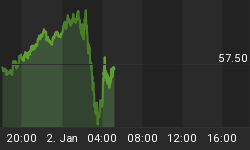Earlier this week, the Treasury Department released the latest data on foreign investments in U.S. financial assets (through November). There was a sigh of relief in some quarters. Here's why.
In the previous report, some people had ominously noted the low inflows into U.S. stocks for the month (October). It is generally unwise to draw major conclusions from one month's reading in a monthly data series, and that is particularly true here. As the chart below shows, monthly foreign flows into/out of U.S. stocks is extremely volatile.

Even a six-month moving average, shown in the next chart, is slow to yield real insight.

The "big picture" takes time to develop - don't be hasty in extrapolating one month's data or in drawing conclusions from it. The big picture is shown in the next chart.

The chart above shows "the kindness of strangers" - foreign strangers - who have invested a lot of their money in U.S. financial assets. As the chart shows, capital inflow continues. However, just like us, their investment preferences change over time, as shown in the next chart.

As the chart above shows, their preference has been bonds over stocks - particularly since about 2002. Is that so surprising, given the 2000-01 debacle in tech stocks, and the continuing malaise in our stock market, overall?
We are aware of the significant amount of foreign exchange (forex) intervention by foreign central banks - buying dollars (raising the value of the dollar), which are then invested in bonds (generally T-bonds), keeping our bond yields lower than they otherwise might be. It is not germane to this essay, so we won't get into it here.
We share the concern of those analysts and economists who worry that the day might (will?) come when these foreign strangers (individuals and/or central banks) will reduce their net, aggregate investments in U.S. financial assets. Worse, we all fear, is that they might take their money and run, turning capital inflows into capital outflows. This asset liquidation - should it someday occur - would drive stock and bond prices down (and yields up), and the conversion of their dollars into their own currencies (repatriation) would drive the dollar down. It is a legitimate concern - but there is no sign of any such change in the data. Speculation of an imminent reduction, or reversal, in foreign capital flows is just that - speculation.
We believe that a reduction in foreign capital inflows, if or when it comes, will occur gradually, possibly accelerating over time. And, that a stampede in capital outflows, if it ever comes, is more likely to be a climactic ending rather than a climactic beginning. But, that's our speculation. Clearly, no one knows.
Conclusion:
-
Monthly data is very volatile, and of little use
-
Trend changes take time to become evident
-
Current data shows no sign of any meaningful reduction in capital inflows
-
No one knows if, or when, the trend will change
-
We have little confidence in any prediction of an imminent change
















